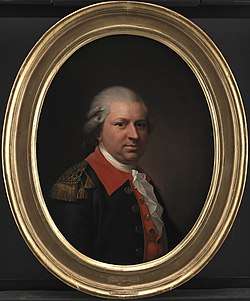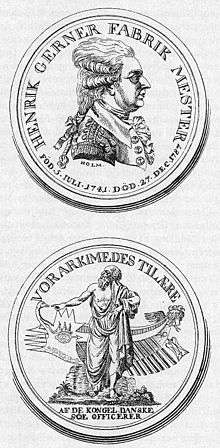Henrik Gerner
Henrik Gerner (1742–1787) was a Danish naval officer who specialised in shipbuilding and naval architecture. His interests as an entrepreneurial engineer led to unsinkable gun platforms, horse-driven dredging machines, and desalination equipment for Orient-bound trading ships.

Early life and naval career
The greatgrandson of the bishop of the same name, Henrik Gerner was born on 5 July 1742 in Copenhagen and baptised in Holmen Church[1][Note 1] and married in the same church on Christmas Eve 1773, Henrik Gerner became a volunteer cadet at the naval academy in 1755, sailing to the West Indies in the frigate Christianborg before becoming a full cadet the next year.
Gerner graduated from the Naval Cadet Academy in Copenhagen as a junior lieutenant in 1763, where he was already interested in the art and science of shipbuilding, and in 1764 sailed with the frigate Falster to Russia and Sweden, receiving expenses for the studies of ships, ships' carpentry, and the ironworkings for anchors and cannon. In 1765 he was promoted to senior lieutenant and joined Prins Friderich in 1766.
He was a close colleague of Ernst Wilhelm Stibolt and they obtained junior positions in the Construction Commission[Note 2] They were in England together studying ship building from 1768, and promotion for Gerner to Kaptain Lieutenant came in 1770. After a shorter spell in France, continuing his studies, Gerner was recalled to Denmark in 1772 and given the post of fabrikmester at Holmen and full membership of the Construction Commission. After further promotion he became a member, in 1776, of the Commission on Naval Defence and that same year was instrumental in founding the Ship Construction School.[2]
Ship building
Some 117 ships of a variety of types and sizes are recorded [3][Note 3] as designed and built by Gerner, including 18 ships-of-the-line and 11 frigates. Of these, the following are notable
- Ditmarsken, lost to the British at the Battle of Copenhagen (1807)
- Friderichsværn, captured August 1807 before the Battle of Copenhagen. See Gunboat War
- Justitia, lost to the British at the Battle of Copenhagen (1807)
- Kronprinds Frederik, lost to the British at the Battle of Copenhagen (1807)
- Mars, lost to the British at the Battle of Copenhagen (1807)
- Neptunus (1789), lost to the British at the Battle of Copenhagen (1807)
- Skiold, lost to the British at the Battle of Copenhagen (1807)
- Tre Kroner, lost to the British at the Battle of Copenhagen (1807)
- Æolus (1783)
- Den Gode Hensigt, was a merchant ship built for the East India trade, and chartered by British merchants.[4]
Defence works
- Floating Battery No.1, (1787), an unsinkable platform heavily armed with 24-pound cannon survived the Battle of Copenhagen (1807) but was decommissioned the following year.
Other engineering achievements

- Dredging machine. In 1783 a novel machine for dredging the harbours and creeks excited public imagination. Prior to Gerner's new invention powered by horses, the clearing of mud and silt from the channels was a very labour-intensive project in order to allow ships to be hauled up and their bottoms scraped and cleaned.[5]
- Desalination
Commemoration
The Gerner Medal "for the naval cadet who showed the best insight and understanding of the science of seafaring, especially mathematics" was first presented in 1792. Its history was later associated with the sword of honour. Both honours are still available today - see da: Gerners Medalje. One hundred years after Henrik Gerner's death, a 72-page appreciation of his works and character was published in memoriam.[6]
Two ships of the twentieth century Danish navy have borne his name
Notes
- This same reference notes that the epitaph and gravestone have misreported his year of birth!
- The Construction Commission, first formed in 1739, had a remit to examine all technical drawings and associated documents of the fleet's ships., and to act as forum for the development of young naval officers, thus ensuring a certain continuity and training for future chief designers.(orlogbasen)
- To access the list click orlogbasen then>database>AVANCEREDE> set Konstruktør to Henrik Gerner >Søg!
References
- Topsøe-Jensen vol I page 451
- Topsøe-Jensen vol I page 452
- Danish Naval Museum
- Christensen
- Giødesen page 2
- Giødesen - all 72 pages
- HDMS Henrik Gerner (1928) in Danish
- HDMS Henrik Gerner (1964) in English
Bibliography and external links
- Balsved's Danish Naval History in Danish (more complete than the English version)
- (in Danish) Christensen, Benny: Den Gode Hensigt
- (in Danish) Giødesen Mindeskrift om Henrik Gerner, Flaadens Fabrikmester by P. F. Giødesen, commander of the Naval Lieutenants Association
- Royal Danish Naval Museum in English
- (in Danish) Royal Danish Naval Museum in Danish
- (in Danish) Project Runeberg Both Gerners appear on the same page!
- (in Danish) T. A. Topsøe-Jensen og Emil Marquard (1935) “Officerer i den dansk-norske Søetat 1660-1814 og den danske Søetat 1814-1932“.